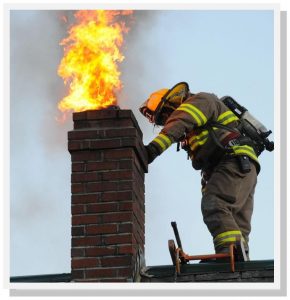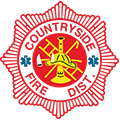 Each year thousands of homes experience chimney fires due to improper maintenance of their chimney. In fact, most chimney fires are caused by creosote, which is a by-product resulting from the incomplete combustion of wood. It builds up on the sides of your chimney as a liquid and later condenses into a solid. As it builds up it not only blocks the flue, but can ignite into a fire.
Each year thousands of homes experience chimney fires due to improper maintenance of their chimney. In fact, most chimney fires are caused by creosote, which is a by-product resulting from the incomplete combustion of wood. It builds up on the sides of your chimney as a liquid and later condenses into a solid. As it builds up it not only blocks the flue, but can ignite into a fire.
However, these fires can easily be prevented. If you have never had your chimney cleaned and inspected or it’s been a while, CFPD encourages you to take these precautions to prevent a chimney fire in your home by following these steps:
- Clean your chimney. It is recommended that you have your chimney professionally cleaned and inspected at least once a year. A professional chimney sweep will do more than brush out your chimney. They will also inspect your chimney for cracks, damage to liners, improper installation and much more.
- Use dry wood. If your wood is not fully cured or is wet, it will not burn as hot as dry wood normally does. It will also produce more smoke. Burning wet wood can also lead to creosote building up faster in your chimney. NOTE: Be sure NOT to burn construction scraps, treated woods or any sappy pines, which can contribute to the creosote buildup.
- Burn your wood stove in the “burn zone” daily. If you burn your wood stove hot enough on a regular basis, it will reduce the build up of creosote.
- Burn the hardest firewood you can find. Burn hard woods, i.e., hickory, ash, or maple that have been seasoned for at least one year. Additionally, build smaller fires as large compact bundles of wood produce cooler fires.
- Lack of air supply also causes chimney fires. If your fireplace cannot draw in enough air, creosote forms. Make sure your damper is open, and once fire is going keep glass hearth doors open to encourage airflow.
SAFETY PRECAUTIONS
- Never leave your fireplace unattended.
- Do not use flammable liquids to start or accelerate the fire.
- Keep the area around the chimney or woodstove clear of any debris, decorations and flammable materials.
- Installing CO detectors in your home is the finishing touch to provide peace of mind and keep your family safe throughout the year, not just during the cold winter season when we have our fireplaces on.
Here are some warning signs of a chimney fire…
- Puffy creosote with rainbow-colored streaks that has expanded beyond its normal form.
- Damper metal and/or metal connector pipe are warped.
- Cracked or collapsed flue tiles or tiles with large chunks missing.
- Discolored or distorted rain cap.
- Flakes or larger pieces of creosote found on the roof or ground.
- Cracks in exterior masonry.
For a printable brochure click here.

